



09, October 2024

Artificial blood vessels are synthetic constructs designed to replace damaged or diseased blood vessels, offering a life-saving solution for patients with cardiovascular and other vascular diseases. With the rising prevalence of cardiovascular disorders worldwide, the demand for advanced therapeutic interventions like artificial blood vessels has surged. The Global Artificial Blood Vessels Market is projected to expand at a CAGR of 6.89% from 2024 to 2032, driven by key factors such as the increasing incidence of blocked blood vessels and the growing aging population.
In addition, the rising demand for minimally invasive surgical procedures is propelling the need for advanced vascular grafts. This surge in demand, coupled with the prevalence of conditions such as peripheral artery disease and aortic diseases, is pushing the artificial blood vessels industry to new heights. As these trends continue, innovations in artificial blood vessel materials and applications are expected to shape the future of vascular healthcare.
Explore in detail about this market in our FREE sample
The rising prevalence of cardiovascular diseases (CVDs) is a major factor driving the rapid growth of the artificial blood vessels market. According to the World Health Organization (WHO) , CVDs are the leading cause of death globally, accounting for approximately 18 million deaths annually. This alarming statistic underscores the urgent need for innovative treatments for conditions such as blocked blood vessels, peripheral artery disease (PAD) , and aortic issues, including acute abdominal aortic aneurysms.
Advancements in tissue engineering are further enhancing the development of artificial blood vessels, particularly in the Asia-Pacific region. Countries like China, India, and Japan are experiencing significant growth in their medical infrastructure, which is increasing the demand for artificial blood vessel applications in various cardiovascular procedures.
Notably, China achieved a significant milestone with the approval of the first domestically manufactured artificial blood vessel by Jiangsu Bioda Life Science Co, supported by the National Medical Products Administration (NMPA) . This approval illustrates China’s advancing capabilities in med-tech innovation and regulatory support for advanced medical devices.
Moreover, government healthcare initiatives, such as China’s ‘Healthy China 2030’ strategy, provide a robust foundation for the development of advanced medical technologies, including artificial blood vessels.
Artificial blood vessels are constructed from various materials, each offering distinct advantages based on their medical applications. The three major types include:
Among these, Expanded Polytetrafluoroethylene (ePTFE) is currently leading the artificial blood vessels market. Its exceptional biocompatibility, flexibility, and durability make ePTFE vessels particularly advantageous for vascular grafting procedures. They significantly minimize the risk of infection and blood clot formation, making them a favored choice in cardiovascular surgeries.
Polyethylene Terephthalate (PET) and Polyurethane are also gaining traction, especially in specialized applications. PET is commonly utilized for large-diameter vascular grafts, while polyurethane is preferred for its elasticity and ability to mimic the properties of natural blood vessels.
With ongoing research and technological advancements, all three materials are expected to see growth. However, ePTFE remains the dominant choice due to its extensive applications in both large-scale vascular reconstructions and smaller peripheral artery repairs.
Connect with our experts for a simplified analysis!
The application of artificial blood vessels is broadening, particularly in the treatment of peripheral artery disease (PAD), hemodialysis, and aortic diseases. With PAD projected to affect around 200 million people worldwide, it has become a significant focus for the industry. Additionally, artificial blood vessels are essential for hemodialysis patients requiring reliable vascular access, especially as the global hemodialysis population grows in North America and Europe. Companies like W.L. Gore & Associates and B. Braun are leading the charge in developing durable and biocompatible solutions to address this rising demand.
In the field of aortic diseases, including abdominal aortic aneurysms, artificial blood vessels play a critical role in preventing fatal ruptures. Market leaders are continuously refining their products to meet the needs of patients, resulting in an influx of innovative solutions tailored for both peripheral and central vascular conditions.
Emerging technologies, such as 3D bioprinting and nanotechnology, are set to revolutionize the production of personalized vascular grafts, enabling the creation of custom-fit blood vessels that drastically reduce rejection rates and improve surgical outcomes. Additionally, the development of biomimetic materials that mimic the natural behavior of blood vessels will enhance functionality and longevity, facilitating smoother integration with the body and minimizing complications like clotting or infection.
For investors and stakeholders, the market presents considerable opportunities, particularly in advanced vascular graft development and minimally invasive surgical procedures. As demand continues to rise, especially in emerging markets like Asia-Pacific, the artificial blood vessels industry is set for substantial growth and innovation in the years to come.
Explore our Latest Release for the 2024-2032 Market Analysis
Artificial blood vessels are typically made from materials like Expanded Polytetrafluoroethylene (ePTFE), Polyethylene Terephthalate (PET), and Polyurethane, which offer durability, biocompatibility, and flexibility.
Q2) What is artificial blood?Artificial blood is a substitute that mimics the function of real blood, used in transfusions when human blood is unavailable or unsuitable.
Q3) What are the key applications of artificial blood vessels?Artificial blood vessels are widely used in treating peripheral artery disease, hemodialysis, and aortic diseases, providing vital solutions in cardiovascular surgeries and dialysis procedures.

Prevalent cases of terrorist attacks in today’s world is increasing the need for severe standards of security for public safety, and the global market for biometric technology scrupulously accommoda..
Prevalent cases of terrorist attacks in today’s world is increasing the need for..